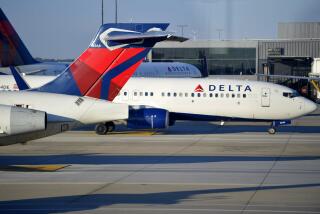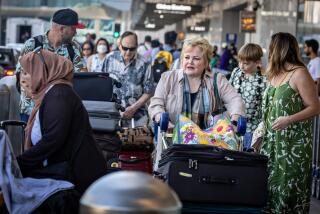Airports: Are we any safer?
On May 1, 1961, Inez Harlow flew into the history books.
The 23-year-old flight attendant had been suspicious of the slim passenger from the moment he boarded the National Airlines Convair CV-440 in Miami.
“He had dark glasses on, his collar up, unshaven, right out of Mickey Spillane,” Harlow, now Inez McDermott, said in a recent interview. “He was abrupt and rude.”
When she turned around after spending a few minutes in the galley and didn’t see the strange man, she marched toward the unlocked cockpit and went through the curtain.
“I saw him with a gun on the copilot, who looked pea green, and he had his arm around the neck of the captain, with a knife,” she said. “My knees went weak.”
The first aerial hijacking of a U.S. passenger plane had begun.
The crew and the handful of passengers survived the ordeal, in which Puerto Rican-born Antulio Ramirez Ortiz forced the captain to divert the Key West, Fla.,-bound flight to Havana. It was all over in a day.
But for the American people, flying would never be the same.
Fifty years later, U.S. air passengers face a phalanx of background checks, body scanners, metal and explosives detectors and an exacting list of more than 70 prohibited carry-on items, including snow globes and certain types of screwdrivers. They arrive hours early for flights to run the security gantlet and navigate check-in.
At airport checkpoints, they wriggle out of shoes, coats and belts, extract from their carry-ons quart-sized bags of 3-ounce (and not more than that) containers of liquids and gels. They slap portable computers onto conveyor belts, and they hope they don’t get pulled aside for enhanced pat-downs by security officers.
Travelers can be forgiven for asking these two key questions: Is it worth it? And how did we get to this point?
On the first question, doubters abound. But many security insiders answer “yes,” with this caveat: Air travel will never be risk-free.
As for the second question: The fight to secure U.S. aviation has been a halting, painful journey, replete with tragedies and heated debates that have tested our nation’s values. And we’re nowhere near the end.
We are, however, at a crossroads, said terrorism expert Brian Michael Jenkins, senior advisor to the president of Rand Corp., the Santa Monica-based think tank.
As privacy guardians squirm and critics liken pat-downs to groping and full-body scans to virtual strip searches, “we are beginning to approach the edge of passenger tolerance,” Jenkins said.
With air traffic on the rebound, forcing more people to squeeze through checkpoints, the system may soon stagger under its own weight. Many experts are calling for a new approach to screening.
In 1958, when McDermott signed on with National, airline security wasn’t a big issue. In fact, it was nearly nonexistent.
Although the cockpit door on the hijacked plane had a combination lock, captains often left it open and just drew a curtain, she said.
Back then, boarding a domestic flight was a breeze. Even international passengers might arrive only an hour ahead. There were no metal detectors or screening checkpoints. “Carry-on” meant a hat or coat, tossed onto open shelves in the cabin, or whatever fit under the seat.
When Joyce Fagerland of Mercer Island, Wash., a Pan American flight attendant from 1961-75, began her career, “no one ever looked into my handbag, either as a flight attendant or passenger,” she said.
Her initial training included emergency landings, deploying life rafts and even delivering babies, but not, as far as she can recall, coping with a bomb threat or the takeover of an aircraft.
“We were not thinking of hijacking or terrorists,” Fagerland said.
Not that deadly attacks hadn’t occurred. In 1955, a man who apparently hoped to cash in on his mother’s life insurance planted a bomb in her luggage that exploded on a United Airlines plane after takeoff from Denver, killing all 44 aboard. In 1960, a bomb exploded aboard a National Airlines flight, killing all 34 aboard, in what was believed to have been a passenger’s attempt to commit suicide.
But these were isolated incidents. It was only after a series of airliners were commandeered to Cuba, and other 1960s hijackings such as the diversion of a TWA flight to Damascus, Syria, after takeoff from Rome, that the life of the American flier began to change.
In 1969, Eastern Air Lines, a frequent victim of attacks, started deploying a system, developed by the Federal Aviation Administration, that used a hijacker psychological profile, along with metal detectors, to screen passengers and their bags. A few airlines followed.
The system wasn’t mandatory until the 1970s, a turbulent decade when Palestinians launched a murderous attack on a Rome airport; a bomb on a New York to Los Angeles flight was found minutes before it was set to detonate; and a man calling himself D.B. Cooper hijacked a passenger flight, parachuted away with a $200,000 ransom and vanished.
In December 1972 the FAA issued an emergency rule requiring all passengers and carry-on bags to be screened by metal detectors or searched by hand. It also mandated armed guards at boarding checkpoints and organized bomb-sniffing dog teams. Airlines later started using X-rays to scan carry-on bags.
Modern U.S. aviation security was born, and so were the controversies.
Sen. Vance Hartke (D-Ind.) called universal screening “a direct threat to the Constitution.” Lawsuits argued that it violated 4th Amendment guarantees against unreasonable searches and seizures.
Consumer crusader Ralph Nader tried to block deployment of the X-ray scanners, saying it would make radiation exposure “a condition of the right to travel for millions of passengers.”
Airlines fretted about delays and lobbied against being saddled with enforcing the new measures, saying government should run aviation security. Citing the expense, some airports resisted deploying guards.
But after a falloff in hijackings, the outcry faded and passengers mostly adapted to the new strictures. It was hard to argue with apparent success. This sequence would repeat over the decades: disasters, stepped-up security, protests, resignation.
In 1988, after a bomb exploded on Pan Am Flight 103 over Lockerbie, Scotland, and killed 270 people, U.S. airlines began searching and X-raying checked luggage at European and Mideast airports.
In 1998, two years after TWA Flight 800 mysteriously exploded on takeoff from New York, killing 230 people, carriers began using a computer-assisted system to separate certain fliers for extra scrutiny, based on behaviors and a government watch list. (Investigators later blamed the downing of Flight 800 on an equipment malfunction, not terrorism.)
Civil libertarians accused the airlines of racial, national and religious profiling.
But security seemed to be working. Although attacks on passenger jets didn’t end, terrorist hijackings worldwide fell from an average of nine or 10 a year between the late 1960s and late 1970s to three a year between 1987 and 1996, terrorism expert Jenkins said. Attempts to sabotage aircraft also declined, he added.
Then came Sept. 11, 2001.
The coordinated effort by 19 Al Qaeda radicals to commandeer four airliners and crash them into New York’s twin World Trade Center towers and the Pentagon, with the last downed into a field in Pennsylvania, killed about 3,000 people. It was the deadliest terrorist attack on U.S. soil.
Given the carnage, it was easy to forget that it was also the first successful terrorist hijacking of a major U.S. airliner in a decade, despite several thwarted attempts.
The 2001 attack prompted the government to take over passenger screening from private companies and create the Transportation Security Administration. That, and later incidents, also propelled an unprecedented step-up in U.S. aviation security.
The response has followed a familiar pattern: layering more measures on top of old ones.
The pace has been dizzying. In the last decade, passengers have been restricted to one carry-on bag; forbidden to bring aboard scores of everyday items; required to show ID at airport checkpoints; asked to leave suitcases unlocked for inspectors to search (or use TSA-accepted locks); and subjected to increasingly revealing scanning machines and pat-down searches.
At one point, passengers’ names were matched against a security list so flawed that it flagged some government officials, including Sen. Edward Kennedy, for extra scrutiny.
By the end of 2002, a milestone had been reached: All checked baggage at U.S. airports was being screened for explosives and other dangerous materials, an idea pursued by the government in the late 1990s and rejected, by several accounts, for cost reasons. By the end of last year, the TSA had finished implementing a program that requires carriers to collect every passenger’s name, birth date and gender for matching against security databases.
Later this year, we may reach another milestone: another decade without a successful terrorist hijacking or bombing of a major U.S. airliner, despite well-publicized scares and the fatal shooting of three in 2002 at an El Al ticket counter at LAX.
“Worldwide, there is no question that security has worked, at least as a deterrent,” Jenkins said.
But some are asking: At what cost?
George Donohue, a former FAA official who helped the agency investigate explosives-detection technology in the 1990s, is a pilot who says he used to love flying. Not anymore.
“I will do anything to avoid getting on an airplane because of the indignity and the way people treat you,” he said. “It’s a police state.”
Other experts, saying that “one-size-fits-all” universal passenger screening is misguided and unsustainable, are calling for a new system.
“With today’s terror threats, we need to be able to find bad people, not just bad objects,” Giovanni Bisignani, director general of the International Air Transport Assn., a trade group for airlines, said at a news conference last year in Geneva. He said carriers are spending a growing amount on security, now about $7.4 billion annually.
Kenneth J. Dunlap, the group’s global director of security and travel facilitation, said as new technology is dropped into checkpoints worldwide, fewer passengers are being processed per hour and the system may soon be overwhelmed.
The TSA, whose budget has grown from $4.7 billion in 2002 to $7.7 billion today, is also concerned.
“We want to focus our limited resources on higher-risk passengers while speeding and enhancing the passenger experience at the airport,” TSA Administrator John S. Pistole said in a speech to the American Bar Assn. in March, a month when the U.S. Travel Assn., a nonprofit representing the travel industry, endorsed so-called risk-based screening.
The International Air Transport Assn. is proposing a “checkpoint of the future” at which everyone would be scanned for various prohibited items but passengers who pay a fee and submit to background checks might skip steps such as removing coats, shoes and laptops. They would walk from curbside to gate through an automated scanning tunnel, wheeling their carry-ons all the way, and get on their flight.
It would be like 1961 all over again. Except less naive.
More to Read
Sign up for Essential California
The most important California stories and recommendations in your inbox every morning.
You may occasionally receive promotional content from the Los Angeles Times.










